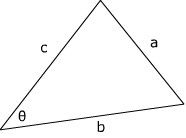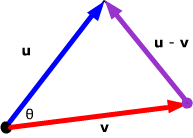- use the geometric properties of the vectors
- use the components of the vectors.
Suppose we start with two vectors u and v, both either in 2-space or in 3-space.

The dot product of u and v is defined to be the scalar
u•v = ||u|| ||v|| cos θ
where θ is the angle between the vectors. (θ is always taken to be between 0 and π inclusive.)
For vectors with components u = [u1, u2] and v = [v1, v2] in 2-space,
u•v = u1u2 + u2v2.
For vectors with components u = [u1, u2, u3] and v = [v1, v2, v3] in 3-space,
u•v = u1v1 + u2v2 + u3v3.

If a triangle has sides of lengths a, b and c and an angle θ between the latter two sides, then
a2 = b2 + c2 - 2bc cos θ.
Now let's apply this law to the triangle formed by u, v and their difference.
 We
get
We
get
||u - v||2 = ||u||2 + ||v||2 - 2||u|| ||v|| cos θ.
Notice that the last term is almost the geometric form of the dot product. Let's solve for it in terms of the lengths of the vectors:
2||u|| ||v|| cos θ = ||u||2 + ||v||2 - ||u - v||2.
You already know how to calculate vector lengths in terms of components, so you can simplify the right-hand side. We'll do it for 2-space vectors; it works the same for 3-space vectors (just include the third component of each vector). Let u = [u1, u2] and v = [v1, v2] .
2||u|| ||v|| cos
θ
= (u12 +
u22) + (v12 +
v22) - {(u1 -
v1)2 + (u2 -
v2)2}
= u12 +
u22 +
v12 + v22 -
{u12 - 2u1v1 +
u22 + v12 -
2v1v2+ v22}
= 2u1v1 +
2v1v2
Divide by 2 to get ||u|| ||v|| cos θ = u1v1 + u2v2.
 Dot
Products of Vectors Dot
Products of Vectors |
||||
| Introduction | Two definitions of dot products | Calculation rules for dot products | Finding angles with dot products | Orthogonal projections |